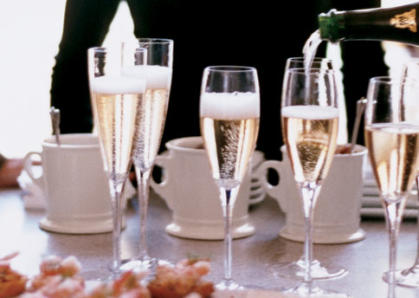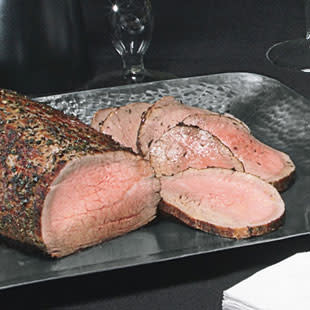6 ways to impress for less on Valentine's Day
Feeling the pinch this Valentine's Day does not mean you have to literally tighten your belt. You and your sweetheart can still enjoy a few luxuries-like caviar, truffles, pâté, and bubbly-without breaking the bank. In our guide, sustainable American caviar substitutes for the pricey imported variety, versatile truffle oil takes the place of scarce shavings, and DIY chicken liver pâté fills in for foie gras. And whether you decide to splurge or save, each item comes with some tips to make sure you get your money's worth.

Caviar
Splurge: Imported Caviar (around $150 per ounce)
Steal: American Caviar (around $20 per ounce)
Caviars from the Caspian and Black seas are considered the finest in the world, but environmental concerns have severely limited their availability in the United States. As a result, imported caviar is either illegal or astronomically expensive. Even if you can splurge on the fancy stuff, there are still sustainability concerns: Some sturgeon populations that produce this top-quality caviar are nearing extinction, which has prompted the U.S. Fish and Wildlife Service to ban the importation of beluga caviar from both the Caspian and Black seas. Osetra and sevruga caviar are still legal, but they are environmentally questionable, not to mention extremely expensive (about $300 for two ounces of osetra caviar at caviarandmore.com).
But if you just can't picture a romantic evening without mother-of-pearl spoons and warm blinis, there's still hope. American caviar is not only sustainable, but-at around $20 an ounce-relatively affordable. America has long been the world's largest market for caviar, and although it's a relative newcomer to caviar production, American companies are already producing highly regarded domestic caviar.
Strictly speaking, only sturgeon roe can be called caviar; roe from any other fish must be modified by the species name, such as "salmon caviar." Several types of American caviar come from sturgeon-including hackleback and Pacific white sturgeon. Sometimes called California osetra, Pacific white sturgeon caviar can be comparable to Caspian caviar. Other American caviars include salmon, trout, steelhead, and whitefish.
For five brands of American caviar we love, see our American Caviar guide.

Sparkling Wine
Splurge: Champagne ($25 and up)
Steal: Spanish Sparkling Cava (around $10)
There's no better way to toast your honey than with a glass of bubbly, but Spanish cava fizzes just as well as French Champagne, usually at significantly less cost. Though the word Champagne is often used to describe all sparkling wine, it can technically only be used for sparkling wine made in a specific region of France, called Champagne. Produced in Northern Spain, cava is made in the same style as Champagne, called méthode Champenoise-"the Champagne method." Cava is aged on its "lees" (dead yeast cells) for less time than Champagne, however, giving it a flavor that is less yeasty and more earthy than its French cousin.
While Champagne is made primarily from Chardonnay and Pinot Noir or Pinot Meunier grapes, the grapes used for cava are mostly Macabeo, Parellada, and Xarel-lo. Using these lesser-known grape varietals also contributes to cava's low price.
Like Champagne, cava is classified in terms of sweetness, from the very dry (brut de brut, brut nature, and brut) to dry (seco) to medium (semiseco) to sweet (semidulce and dulce), with brut the most common. In the United States, the best known producers of cava are Freixenet and Cristalino, both of which produce good quality cava for very low prices-usually around $10.

Truffles
Splurge: Whole truffles or shavings ($400 to $4,000 per pound)
Steal: Truffle Butter ($4.99 for 3 ounces) or Truffle Oil ($20 to $60 for 1 to 8 ounces)
Prized for their exceptional fragrance and intense flavor, truffles are-ounce for ounce and pound for pound-one of the priciest foodstuffs in the world. White truffles have been known to go for around $4,000 a pound; black truffles for around $400 a pound. Why are these edible fungi so expensive? For starters, they are difficult to cultivate. Truffles grow anywhere from 3 to 12 inches underground. Because they are so difficult to find, harvesters use specially trained pigs or dogs to root them out. Once a truffle has been discovered, the farmer has to carefully extract it from the ground and avoid touching it with his hands-the oil from his skin will ruin the truffle. Finally, if the truffle isn't ripe, it must be reburied and harvested later. All that work makes for an extremely expensive final product.
But as wonderful as shaved truffles are, you don't need to buy a whole truffle to give your food a touch of their exquisitely earthy flavor. Truffle butter, which can be made with either white or black truffles, is a considerably more economical way to get a whiff of the intoxicating scent. Typically, small pieces of truffle are mixed with best-quality butter, infusing the butter with their flavor and scent. (D'Artagnan sells delicious black truffle butter for $4.99 for three ounces at dartagnan.com.) Truffle butter can also be made with truffle oil, which has often been artificially flavored. Truffle oil is available at many supermarkets, and is a relatively inexpensive way to add truffle flavor to soups, scrambled eggs, pastas, and risottos, like in our Seared Scallops on Shrimp and Truffle Risotto (pictured).
If you win the lottery and decide to buy a whole truffle, look for one that is firm and round, with a strong fragrance and no bruises or blemishes. Truffles will keep up to three days in the refrigerator, but you should use them as soon as possible after purchase. To take full advantage of your investment, bury the truffle in a container of rice or whole eggs and cover tightly before refrigerating; the scent of the truffle will permeate whatever it touches, giving you an added flavor bonus.

Beef
Splurge: Prime Rib Roast ($18 per pound)
Steal: Choice Rib Roast ($13 per pound) or Eye of Round ($5 per pound)
Nothing says decadence quite like a standing rib roast. But just because we usually refer to it as prime rib doesn't mean you have to buy prime beef. Typically, rib roasts come in two grades, rated by the U.S. Department of Agriculture (USDA): choice and prime. Prime rib roast has more marbling (the flecks of fat that increase flavor, tenderness, and juiciness) than choice rib roast, making it more expensive. But choice rib roast is plenty tender, and the added benefit of prime rib does not always justify the added expense. Stores often label choice rib roast "prime rib," using the common name for the dish rather than the USDA rating. If you are set on buying prime rib rather than choice, make sure that the meat is USDA-certified as prime. For more tips on choosing, storing, and cooking rib roast-prime or choice-see our Beef Rib Roast ingredients page.
An even more economical option is eye of round-one of the cow's four main leg muscles. Because of the leg's exercise, eye of round is less tender than other cuts, but with proper cooking and presentation, eye of round can be a delicious centerpiece entrée. Try our Roast Beef with Dijon-Caper Sauce (pictured), and be sure to slice it thinly to maximize flavor and texture.
To get the best results when roasting any cut of beef, see our tips on Why You Shouldn't Put Cold Beef in the Oven and Resting Meat.

Seafood
Splurge: Lobster (about $18 per lobster, for one serving)
Steal: Monkfish (about $9 for a half-pound, for one serving)
This year's lobster surplus has put prices at a 25-year low, but if the classy crustacean is still too rich for your blood, try looking outside the shell. Long known as poor man's lobster, monkfish has a similarly firm texture and sweet flavor. Monkfish is not an exact substitute for lobster. Still, monkfish's meaty texture and mild taste makes it a great seafood entrée.
When buying monkfish, look for fillets that are white with a tinge of pink; the membrane that is attached to one side of the fillet should be pure gray, with no bruising. Monkfish is also commonly sold as a whole tail, which can range from one to five pounds. The skin should be bright brown or black; you can either remove it yourself or ask the fishmonger to remove it. Monkfish are available year-round, but their best seasons are fall and winter.
For tips on buying and preparing lobster, see our Lobster ingredients page. Or, for the steal, try our Cedar-Planked Monkfish with Fire-Roasted Puttanesca Relish (pictured).

Pâté
Splurge: Foie Gras ($48 for 8 ounces)
Steal: Chicken Liver ($1.99 per pound)
Whatever your moral standpoint on foie gras, your economic outlook may be a little bleaker this year. Known for its unctuous texture and rich flavor, foie gras literally translates as "fat liver." Generally, the term foie gras refers to the liver of ducks or geese that have been force-fed and fattened up, enlarging the liver in the process. Raw foie gras runs between $70 and $110 for 1.5 pounds. One more affordable option is pâté de foie gras, which has the same smooth, buttery taste in a more spreadable form. Plus, because law requires that pâté de foie gras is 80 percent goose liver, you are still getting a top-quality product for your dollar.
But just because pâté de foie gras is more affordable doesn't mean it's cheap. For a truly thrifty-and truly delicious-option, make your own pâté this hors d'oeuvres season. Chicken livers have another added bonus: They're uncontroversial. The BA Foodist's family recipe combines chicken livers with apples, Sherry, and marjoram for a silky-smooth spread that doesn't taste too heavily of liver.
Related:
More from Bon Appétit:
